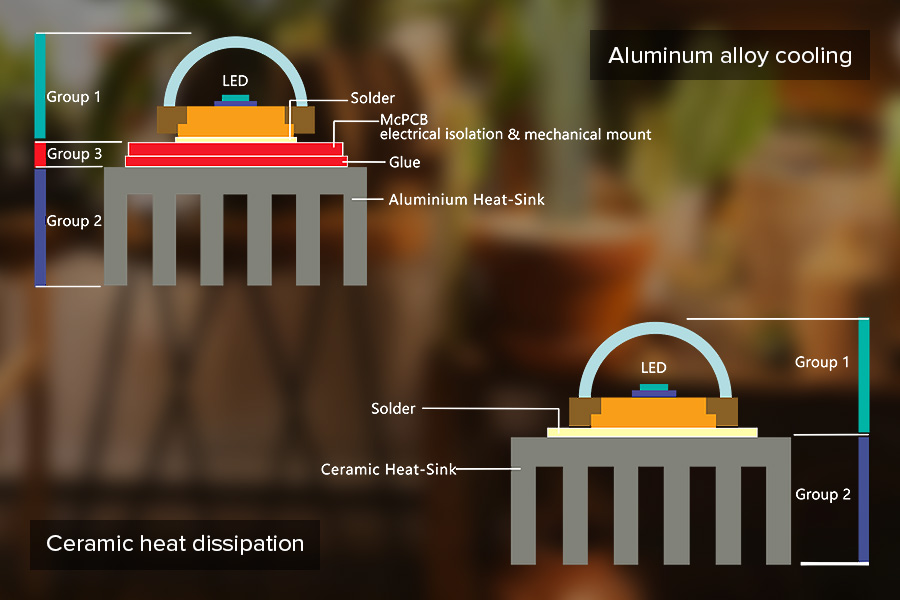
In high-power LED lighting, thermal management is a critical factor determining brightness, lifespan, and stability. Traditional LED luminaires mostly use aluminum substrates for heat conduction. However, under higher power conditions, their thermal conductivity is limited and may even pose safety risks.
Sansi, by adopting ceramic heat dissipation technology and unique luminaire structural design, enables luminaires to achieve higher power density while significantly improving performance in terms of light decay, lifespan, safety, and durability, making them an ideal choice for high-performance LED lighting.
Why choose ceramic?
In traditional LED luminaires, the aluminum substrate primarily serves two functions:
Isolating the circuit layer from the metal baseplate to prevent short circuits
Conducting heat generated by the LED during operation to the surface of the heat sink.

The aluminum substrate consists of a circuit layer, an insulating layer, and a thermal conductive layer, among others. Its thermal conductivity is limited by the insulating layer material (typically epoxy resin), with a thermal conductivity coefficient of approximately 0.3–1.8 W/(m·K), far lower than that of ceramic (industrial 95% alumina ceramic is approximately 22 W/(m·K)).
Ceramic is a rare material that combines high thermal conductivity with electrical insulation. This allows LED chips to be directly soldered onto the ceramic heat sink, eliminating the need for an aluminum substrate, significantly reducing thermal resistance, and improving heat transfer efficiency and safety.
The thermal conductivity of ceramic is much higher than that of aluminum substrates. Furthermore, its coefficient of thermal expansion is close to that of semiconductor materials and is isotropic. Post-soldering, this effectively reduces thermal stress, enabling ceramic-cooled LED luminaires to handle higher power densities. For the same size, they offer greater power and higher brightness.
Additionally, ceramics are primarily composed of silicates such as aluminum oxide and silicon oxide. After sintering at high temperatures around 1600 °C, they form a dense crystalline structure with very low porosity and highly stable chemical properties, effectively blocking the penetration of corrosive media.
Consequently, ceramic heat sinks possess corrosion resistance and reliability that traditional aluminum heat sinks cannot match. When used in outdoor, coastal, or highly corrosive environments, they can significantly extend luminaire life and reduce maintenance costs.
Traditional LED luminaires often use a sealed monolithic structure. When multiple LED chips are concentrated on the same cooling surface, heat tends to accumulate more easily in the central area, forming a "heat island effect."
Sansi ceramic LED luminaires employ a hollow structural design, allowing air to flow from both the front and back into the interior of the heat sink. This effectively enhances natural convective heat transfer efficiency, alleviates heat buildup, lowers the LED junction temperature, and thereby extends the service life.
Simultaneously, traditional bulbs often place the driver power supply in a sealed electrical chamber, causing internal temperatures to remain high, which severely impacts the power supply's lifespan. Sansi addresses this through a hollowelectrical chamber structure, allowing natural air circulation and reducing the chamber temperature by approximately 30%, significantly improving the heat dissipation efficiency and reliability of the driver components.
Higher Brightness, More Energy Efficient:For the same size, ceramic LED luminaires achieve approximately 1–2 times higher brightness and are 30–50% more energy-efficient compared to standard products.
Higher Reliability:Longer lifespan in outdoor or corrosive environments. For example, in a steel mill's pickling workshop, where ordinary LED lights might need replacement every 3–6 months, ceramic heat dissipation luminaires can operate stably for 3–5 years.
Enhanced Safety:Improved electrical isolation and heat dissipation efficiency ensure safer operation.
More Stable Light Quality: Color temperature and Color Rendering Index (CRI) remain stable over long-term use, making them suitable for demanding applications like general lighting and plant growth.
More User-Friendly:Higher performance and longer lifespan within the same physical volume reduce maintenance burdens.
Sansi ceramic dissipation technology is not merely an innovation in materials and structure, it is a systematic implementation of the philosophy of "high-quality lighting"
Through synergistic innovation in materials, structure, and application, Sansi consistently delivers a lighting experience characterized by greater brightness, enhanced safety, extended longevity, and superior stability.
Visit Sansi official website to learn more about LED lighting solutions based on ceramic heat dissipation technology.